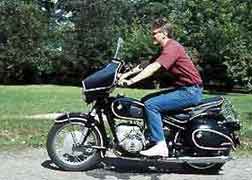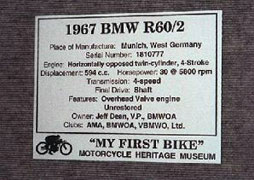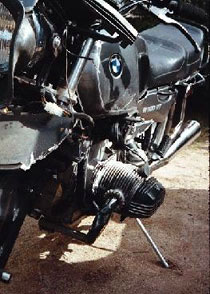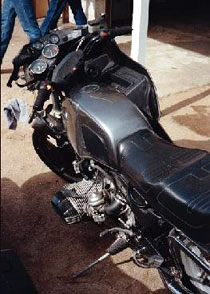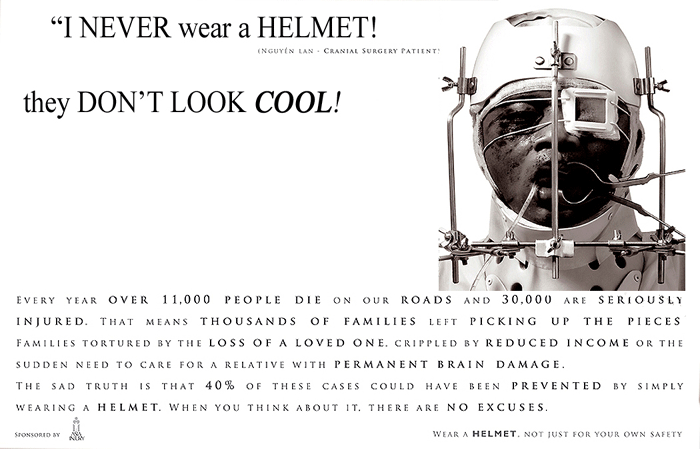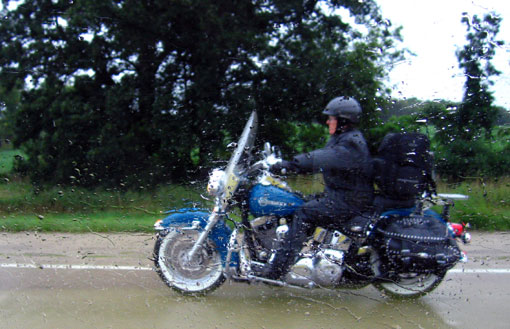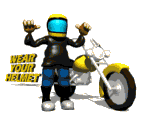Here am I — riding up the fabulous curving road to Kitt Peak, Arizona, on an R1100RT. Life is grand!
Pointed Opinions on Riding Motorcycles!
|
What About Riding a Motorcycle?A “Black Bike.” One day late in the 1950s I saw an upperclassman riding around the Lawrence College campus on a motorcycle unlike any I had ever seen before. (It was over 40 years later that I learned this upperclassman was Tony Bok, of Camden, Maine, Lawrence class of 1960.) It was elegant in its simplicity—black paint with white pinstriping. It was quiet. When I saw Tony riding the black bike, it looked like he was floating. I had no idea what the black bike was. It was four years later that I learned. In 1962, I was in New Haven, Connecticut, and saw numbers of similar black bikes riding up an alley across from the Yale Art Gallery. I walked up that alley and, for the first time, saw the black bikes up close and personal. I had wandered into Libby's Sales and Service, a dealer in Yamaha, Vespa, and BMW. BMW? What was that? That was the black bike. There I met a mechanic with a German accent and he told me about the black bikes and who made them. I could not begin to afford one then, but I could afford to buy owners manuals to aid my daydreaming. So I did, and I have them still today.
The year? 1967. I am riding my first bike, a 1966 R60/2. (Oops. No gear! I was young and foolish then.) My first bike. My life has not been the same since. It was five years after I stumbled into Libby's that I could actually afford to purchase one of the black bikes, a year-old 1966 R60/2. Since then I have owned over 50 BMW motorcycles, of which I still own 15 today. I have put over 300,000 miles on BMW motorcycles since that year, and have learned an awful lot about BMW motorcycles and riding. I have had one serious accident. It sent me rolling at 55 MPH down Mission Road, southwest of Tucson, Arizona. A wheel came off an approaching vehicle right into my path. The motorcycle, a lovely gray R100RT with red pinstripes, was totaled and I went to St. Mary's Hospital with a broken right arm. I had full leathers and a full-face helmet on when the crash occurred, however, so I was spared far worse injury than I experienced. All of which brings up an interesting question about riding motorcycles.
My father, a physician, would not let me ride a motorcycle until I was gone from home and able to afford one on my own. Riding involves risk. You must recogize that it does, and you must accept it. If you do not do this, then do not ride. “Proficient Motorcycling: the Ultimate Guide to Riding Well.” Motorcyclist and author David Hough (rhymes with “tough”) wrote a book by this title that was published in 2000. It is the best book I have ever read on motorcycle operation—eminently readable, well illustrated with photographs and drawings, and full of good information for those of us who wish to survive our riding passions. You can order this book for 34% off from Amazon. David came out with a second book, “More Proficient Motorcycling: Mastering the Ride,” which is also available from Amazon at a 34% discount. Another worthwhile book available from Amazon is the Motorcycle Safety Foundation's “Guide to Motorcycling Excellence: Skills, Knowledge, and Strategies for Riding Right”. Riding is dangerous. When they observe that I am a motorcyclist, acquaintances and complete strangers tell me that riding is very dangerous. The truth is, every activity—and inactivity— is dangerous. Lying in bed is dangerous to a degree. It is what degree of danger each of us finds acceptable that is important. For example, data shows that for every 350 hours of horseback riding, a rider visits a hospital emergency room. That means that riding a horse is twenty times(!) more dangerous than riding a motorcycle. Yet, how often do we see unhelmeted teenage girls riding about the countryside on horses? Accept the risk! In accepting the risk we face, intelligent motorcyclists resolve to deal with it intelligently. They understand their limits as riders, understand the limits of any motorcycle and their motorcycles in particular, focus 100% on their riding environments, and ride accordingly. They also know that no matter how skilled and focused a rider is, he-or-she still is very vulnerable. A fraction of a second's inattention can result in death. On occasion, a focused and skilled rider can still be injured or killed by an unanticipated occurence.
Some riders just do not like motorcycle helmets. If you do not care for your own brain or life, then ride without one — like this brainy rider passing me at a high rate of speed on an interstate highway in the midwest. Heedless Riders. Alas, the highways and byways of America are awash with motorcyclists that doctors and nurses call “organ donors.” How can you identify such riders? Here are some keys:
What is Intelligent Motorcycling?“Most riders think they are both safer and more skilful than the average rider — but we cannot all be right. In more than 90% of traffic accidents, human error is the cause; aaccidents do not just happen by chance. They are the consequence of unsafe riding practices. Riding safety cannot be thought of as an add-on extra. It has to be built into the way you ride.” — Motorcycle Roadcraft: the Police Rider's Handbook (1996).Riding a motorcycle is at least 90% mental. The physical part, the riding skill, must be practiced until it is second nature. When you need to apply maximum braking without loss of traction or swerve quickly to miss something in your way, you must be able to do so unthinkingly—automatically. Most of the time if you focus 100% and apply mental strategies you will not need to test how well practiced your skills are. Most hazardous situations can be defused in advance by the thoughtful and focused motorcycle rider.
|
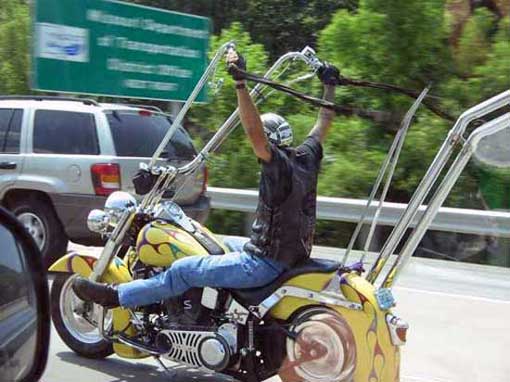 |
-
Intelligent riding involves the entire gamut of motorcycling. It starts before
you mount your motorcycle and even before you buy one. It covers the weather,
what you wear, where you go, how you ride, and what you ride.
 What you ride?
What you ride?
-
Yes, I have wonderful R60/2 motorcycles.
They are fabulous motorcycles, and I love to ride them. But I do so
carefully. I know well that they have relatively lousy brakes and power compared to modern
motorcycles, and do not handle nearly so well. I use them as kind of magic
carpets to my youth. When I ride one, for a few minutes I feel like I am 27
years old again. But I would be an idiot to use one as my primary
transportation across America. Why? Because it does not have a whole host of
things that make for a better motorcycle and add to my safety.
What sort of motorcycle does an intelligent rider choose? He or she definitely wants one with excellent and powerful anti-lock brakes (ABS), superb handling, sufficient power, standard handlebars and seating ergonomics, and a fabulous front and rear supension with plenty of travel. If you plan on riding long distances, you need comfortable saddles, comprehensive weather protection, adequate luggage space, an alternator putting well over 500 watts, and an upright, but slightly leaning forward, riding position. For a touring motorcycle you will want to add accessories such as a tank bag, headlight modulator, additional driving lights, and flashing brake lights. Tubeless tires are good because they can be temporarily repaired on the road.
 How you ride.
How you ride.
-
I will touch here on only a small segment of the intelligent-riding universe. Those street survivors reading this can certainly add their own points to this list.
- First, I failed to focus completely on riding. I turned my head for just an instant to look at something behind the RT. That was all it took. When I looked back forward, I was on top of the car. No time, even, to touch the brakes. I try to concentrate 100% on riding, but I do not always succeed.
- Second, I was following too closely the car in front of me. I had allowed perhaps only one second following distance. Stupid? Of course. Had I allowed at least two seconds the crash might have been avoided.
Failure to focus on riding. You have all seen cars with drivers talking on cell phones. Data shows that such drivers are four times more likely to crash than drivers that do not use cell phones while they are driving. And it makes no difference whether it is a hands-free or hand-held cellphone:
 |
All of these things can distract a rider from what he or she should be doing, which is riding the motorcycle! I used to own a BMW K1200LT motorcycle, which came with a three-channel radio with search/seek feature, trip computer, tape deck, tank bag map holder, and CD player (I removed the latter to conserve luggage space). Initally, it was fun to play with all the gadgets while riding the LT. Eventually I realized that they can be serious distractions I often should avoid. After a while I rarely use the radio system, except to check the weather channels. On long trips I often refer to a tank-bag-mounted map, but I am more careful when I glance at it.
“Inattentiveness is a major cause of accidents.” — Motorcycle Roadcraft: the Police Rider's Handbook.
I need to focus as much as possible on the riding task; you do too.
Assume you are completely invisible to other vehicle operators. This is the single most common piece of advice I receive from other motorcycle operators. And it is very good advice. No matter how much you do to make yourself visible — bright clothing and helmet, additional driving lights, headlight modulators, etc. — assume you totally invisible. Sadly, police motor officers with lights and siren going have been killed by motorists who said did not see them. If that can happen, don't you think it could happen to a civilian rider?
All sizes of trucks as well as motorhomes, vans, etc. Stay away from these vehicles, most especially uncovered trucks—including pickup trucks. Such vehicles block your view of the roadway and other vehicles. Detrious can fly off them or up from under them right into your face. Their drivers often cannot see you. If you have to follow them for a distance, give them at least four seconds in following distance, twice the recommended normal two-second distance. When you pass large trucks and motorhomes, do not do it slowly. Pass them quickly. Get past them as fast as you can to minimize your exposure!
It takes a 40-ton 18-wheeler traveling 60 miles-per-hour 530 feet to stop — about 400 more feet than a motorcycle. So do you want a semi close behind you? Do you want to move right soon after passing a semi?
Sitting-duck riders. That is what I call riders who ride along for long periods in the same wheel track, usually the left one. Clearly, they are oblivious to the hazards all around them. They are fixated on one wheel track—period. They can be picked off at almost any time by drivers heading toward them, especially left turners. When riding, continuously maintain as large a space cushion around you as possible. Often that means weaving thoughtfully from wheel track to wheel track when riding two-way roads in order to keep as much distance as possible between you and approaching traffic. It certainly means never riding side-by-side with a another motorcyclist or riding in tightly packed groups of riders (I avoid group riding for this reason).
Riding multilane highways with three or more lanes going in one direction presents a special problem in keeping your distance from other vehicles. Riding in the left lane can be a problem because drivers going faster than you come up on you. Riding in the right lane poses problems because of entering and exiting drivers and slower traffic found there. Riding in the middle lane means you are vulnerable from both sides. Often, I find that the safest place is the left lane, when you avoid dangerous entry and exit traffic as well as double-sided vulnerability. However, conditions change constantly, so no single lane can be called the best.
Maintaining as large a space cushion around me as possible is one of my most critical riding strategies. I work at that constantly whenever I ride. My space cushion is in front of me, on both sides, and to the rear. If they cannot reach me, they cannot hurt me. I keep my distance. You should, too.
Blind spots. Another critical riding strategy is the avoidance of blind spots. That refers to areas around another vehicle where you as a motorcyclist are invisible to the other driver. Trucks have enormous blind spots—no, they have blind acres. If a driver cannot see you, he can hurt you. It has happened many times. Pass through blind spots no less quickly than passing a big truck. Never, never ride in another vehicle's blind spot. Your survival depends on it. Your strategy should be to ride from visible spot to visible spot efficiently and without delay.
Riding without practicing. The old saying goes, “Practice makes perfect.” This is very true for motorcycle riders. Many riders do not practice their riding skills regularly; some do. The latter are more likely the survivors. We all should practice critical hazard-avoidance skills routinely. These include maximum straight-line braking, braking in a curve, and swerving. These skills can save us, but not if we do not have them right at hand when we need them. In 1999 a west-coast state motor cop died when his motorcycle collided with another vehicle. Accident reconstruction showed that he failed to use his front brake at all, and that had he done so he would have stopped short of the vehicle he hit (the front brake contains perhaps 80% of our stopping capacity). We should practice critical skills so routinely than they can come into play when needed automatically. How can you practice? When you are riding on a deserted road, stop as quickly as you safely can. Repeat that several times to improve your skill, each time stopping a shorter distance. Remember: the key is squeezing ever more firmly on the front brake to the point of impending front-wheel skid, while simultaneously easing up on the rear brake pedal to prevent a rear-wheel skid. On that same road, practice swerving, starting slowly and increasing your speed to highway speeds. Swerve by pressing forward on alternate handgrips, or by countersteering—that is the most powerful way to change the path of a motorcycle. Swerve as firmly as you safely can around imagined hazards.
“Inattentional Blindness” or “IB” is a new field of research with important ramifications for all riders. We all know about this: “Gee, officer, I'm so sorry; I didn't see the motorcycle before I cut in front of it!” For background on this area of research, click here. It could save your life!
Fatigued rider. On long motorcycle trips, I can become quite tired while riding. My eyelids start to droop and I fail to pay as much attention to the riding task. Fatigue is a serious impairment, just like drinking alcohol, and it can cause a crash. Motorcyclist Larry Gillen, of Indiana, even conducted a survey and wrote a paper, Motorcycle Rider Fatigue, on the subject.
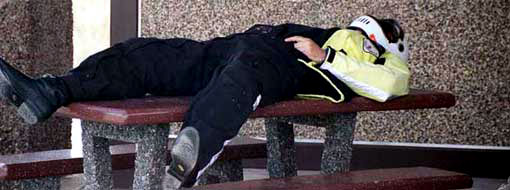 |
When I become fatigued while riding, I try various things to hold off sleep. I sing loudly to myself. I calculate distances traveled and yet to go. I move around in the saddle. I do deep breathing. But eventually more is needed, and this is when I pull over and take a power nap of 15-20 minutes’ duration (yes, that's me in the photo above). I am always amazed how refreshed I feel after such a brief nap. Some days I need only do this once — usually after lunch. Some days I need to do it twice. But I have found the power nap extremely effective on long trips.
Keeping your distance. Recently, I rear-ended an automobile at about 15 MPH while riding an R1100RT. The collision was more violent than I would have thought for such a low-speed crash. I was thrown high over the RT's windshield—completely missing it—“like a rag doll,” according to the Kawasaki rider behind me. Except for a couple of large, pretty purple bruises and some small scrapes, I was uninjured. My hapless RT was the real victim. It suffered over $4,000 in damage to the front end. The car? Completely unscratched.
Why did this happen? Two reasons.
Pay 100% attention to operating your motorcycle when you ride. O.k., 99%, then. Force yourself to scan forward and to check your mirrors regularly. Maintain a minimum two-second following distance at all times. Safety experts are now recommending a three-or-four second minimum. Keep your distance from vehicles ahead of you and behind you. If a car or truck fills up too much of your rear-view mirror, increase your following distance more to make up for what the driver behind you is failing to provide. If the driver behind you gets uncomfortably close to you, pull over and let him/her by—it's easier to do this on a motorcycle than in a car, and I do it a lot.
The basic axiom is this: keep your distance from all other vehicles on the roadway! Whether they are in front of you, behind you, beside you, catching up to you from behind, or approaching you from the front, keep your distance! The Motorcycle Safety Fondation says to maintain a “space cushion.” Whatever you call it, keep your distance.
Becoming an older rider. I am an “older rider” now. Baby boomer are rejoining returning to riding. The average age of the motorcycling community is aging. MSF notes, “One of every three drivers in America is now over 55 years of age. The typical U.S. motorcycle owner is about 41 years old compared with 24 years old in 1980.” We no longer have the reactions, stamina, and vision we had decades ago. We cannot see as well, especially at night. Our eyes do not adapt as quickly to changes in lighting. We cannot react as quickly to hazards that appear suddenly. We tire sooner.
A professor at the University of Southern Mississippi published a study on older riders, “Older Motorcyclists: Continuity or Change?” The Motorcycle Safety Foundation published a “Seasoned Rider Module Fact Sheet” and curriculum for older riders.
As we age, therefore, we need to ride smarter and be aware at all times of our limitations.
Towing a trailer with a motorcycle. In a word, don't do it! No motorcycle manufacturer recommends pulling a trailer with any of its motorcycles. I know of a couple riding a Honda Gold Wing that suffered a blow-out of one of its trailer's tires and the operator lost control. Both riders died. Even pulling trailers with an automobile can cause serious accidents if not secured properly.
Riding a motorcycle involves risk, of course. Riding without a helmet increases your risk dramatically. Riding "invisibly" with black jackets and black helmets increases your risk. Riding while impaired increases your risk. Lots of choices a rider makes can increase or reduce risk. Certainly, pulling a trailer with a motorcycle increases your risk. I believe we should strive to manage and reduce our risk, but it certainly is each rider's choice as to how much or how little he/she wishes to manage his/her risk.
Personally, I will not ride impaired, I will not ride without a helmet, I ride with brightly colored clothing to increase my conspicuity, and I would never pull a trailer with a motorcycle. If you need to take that much stuff with you, then I recommend putting the motorcycle on a trailer and tow it with a car or truck.
 |

